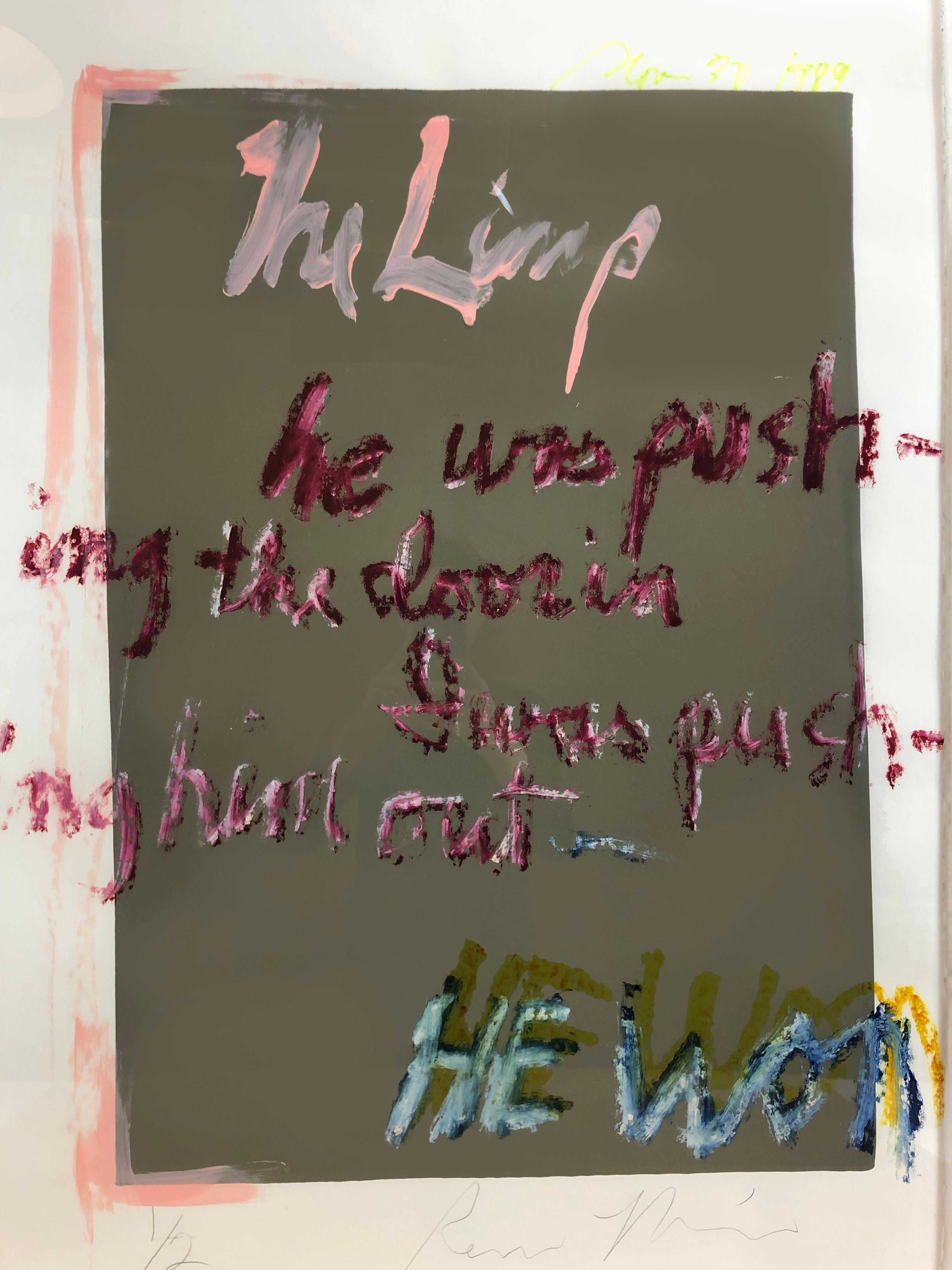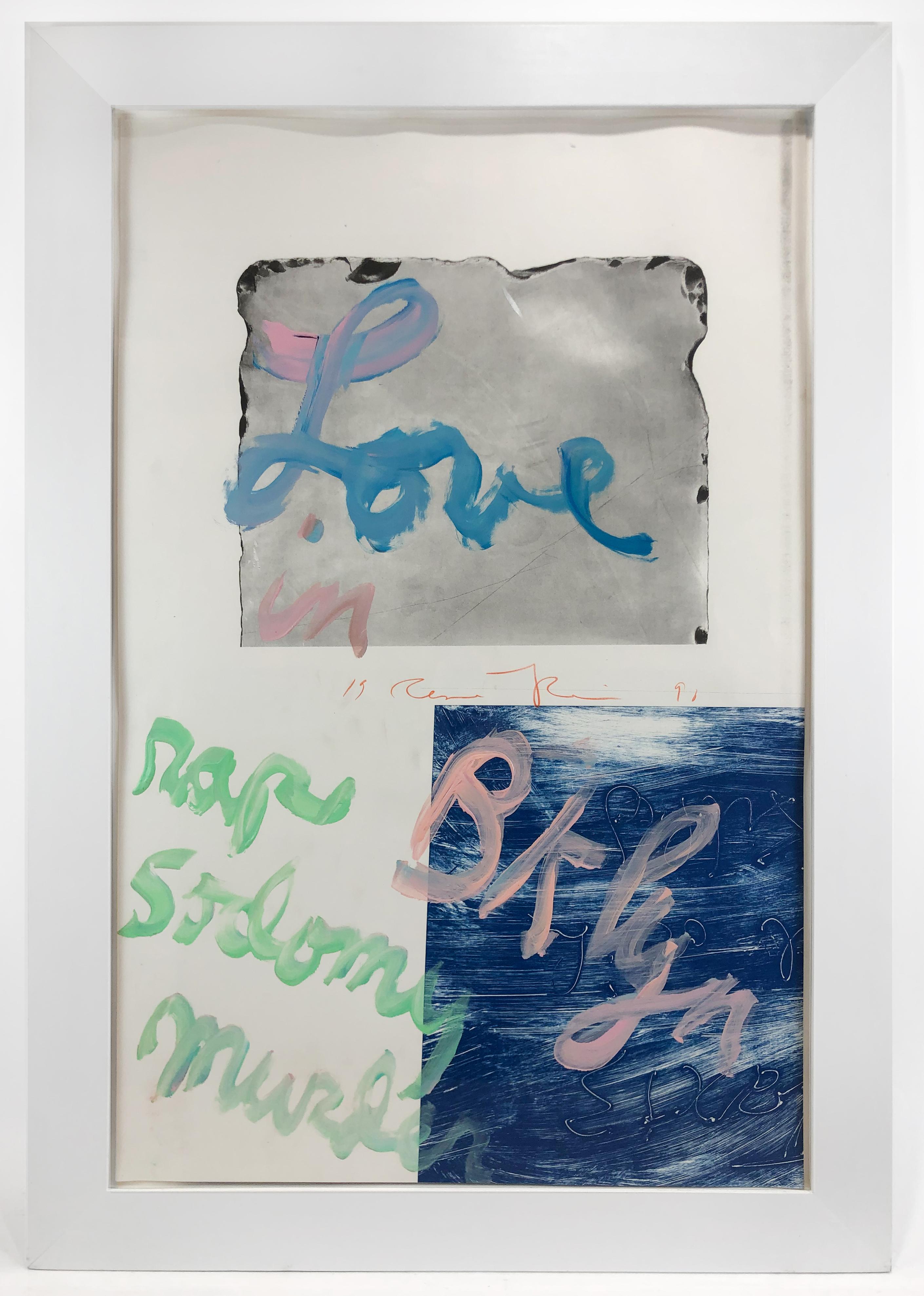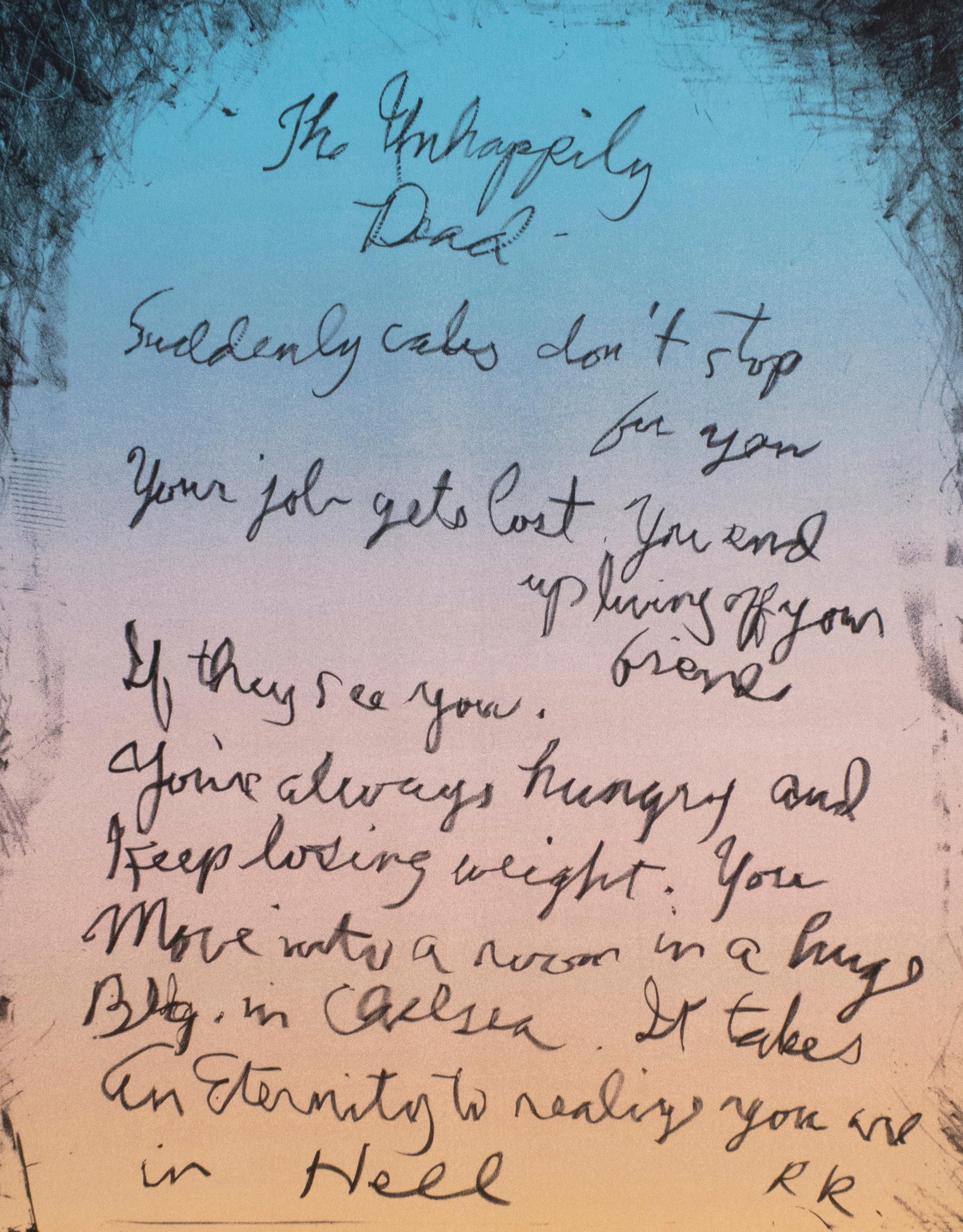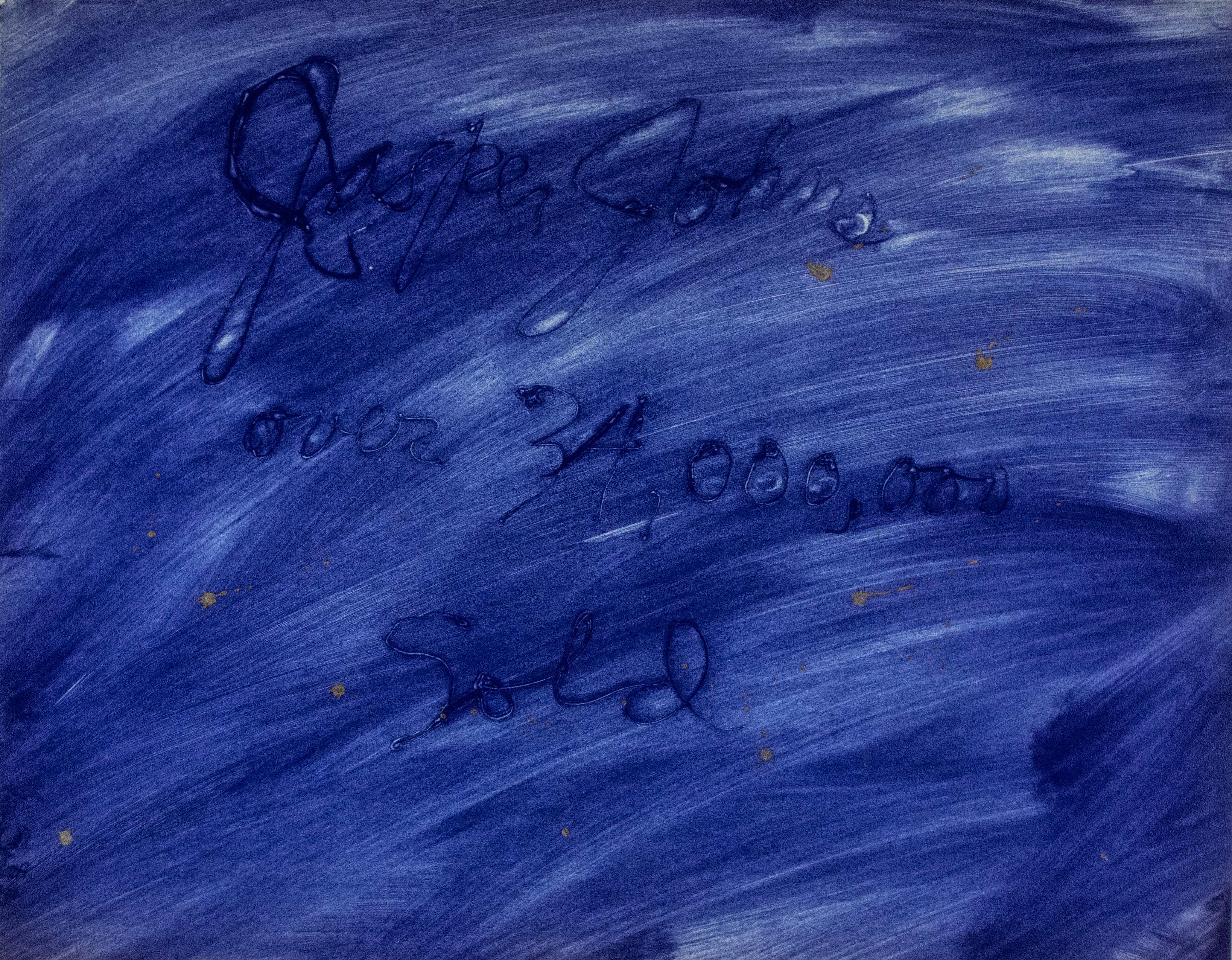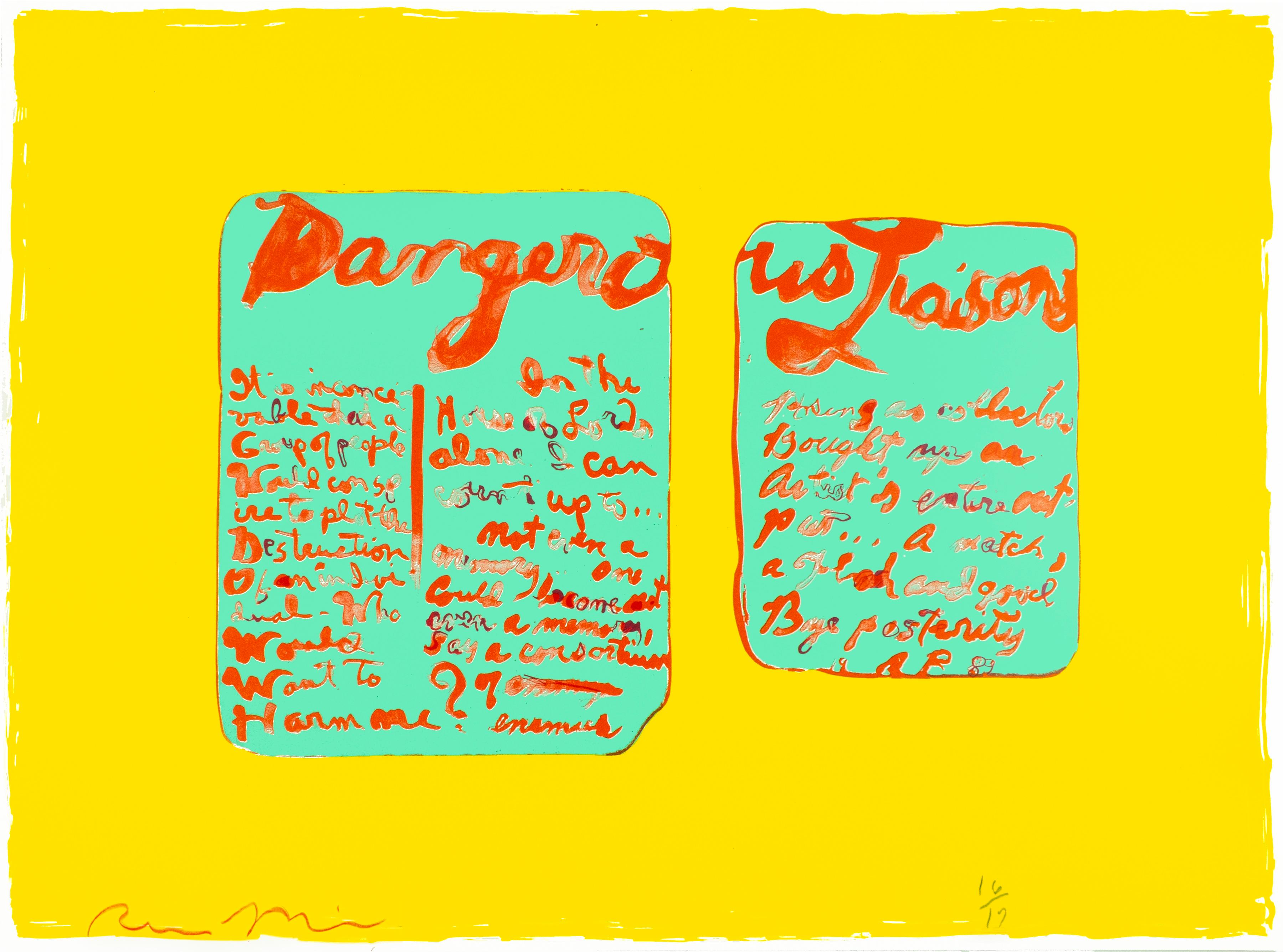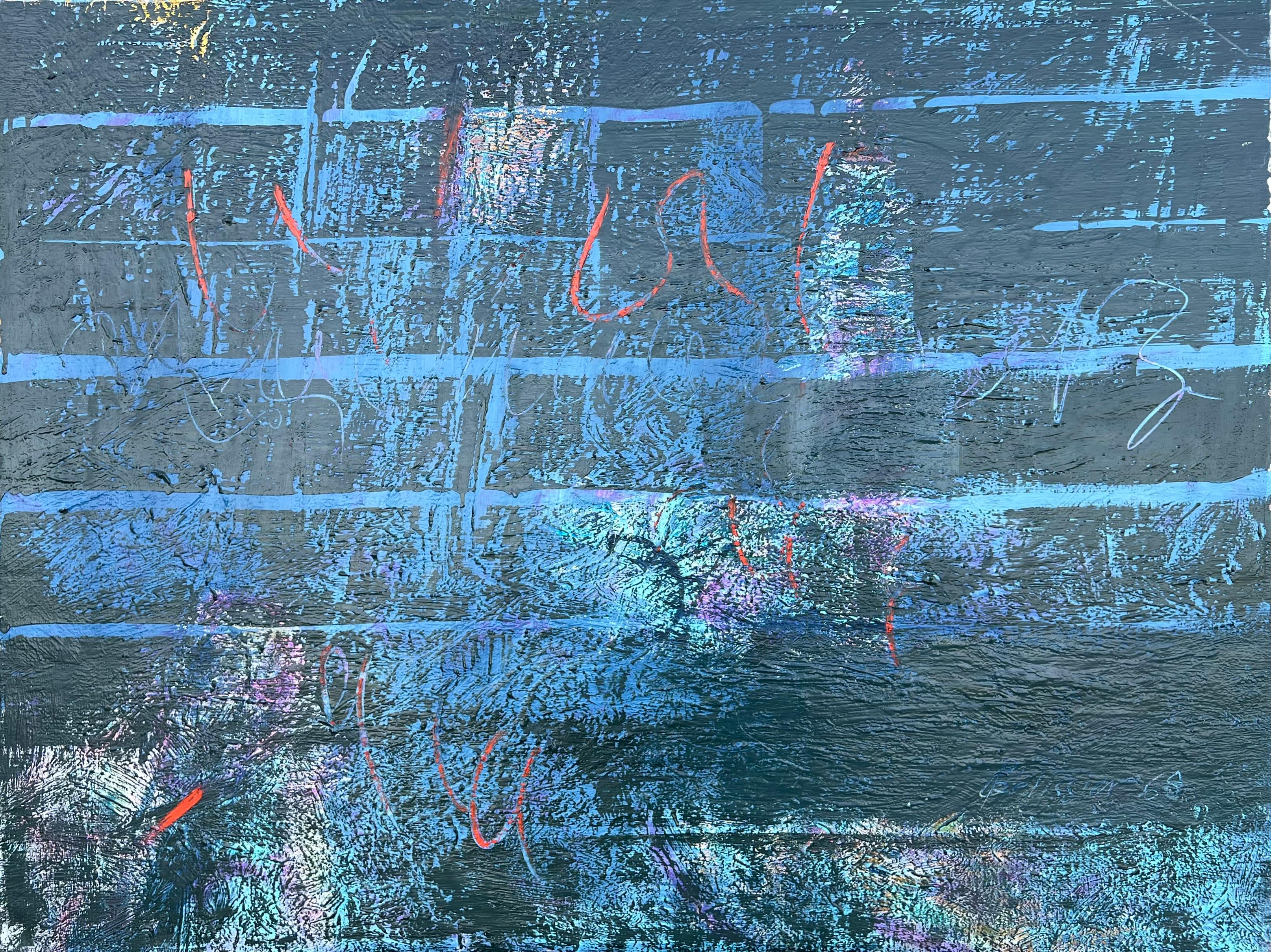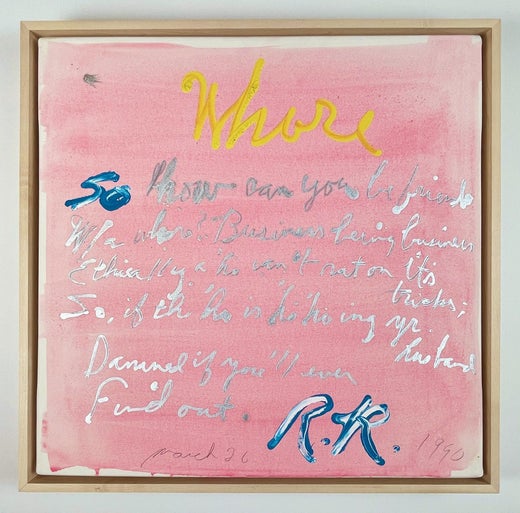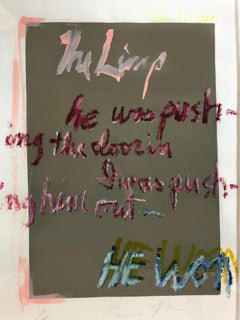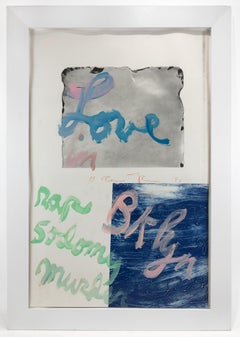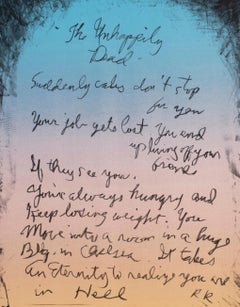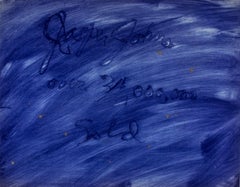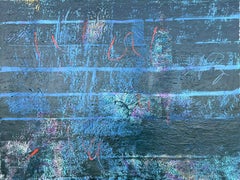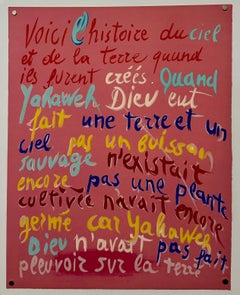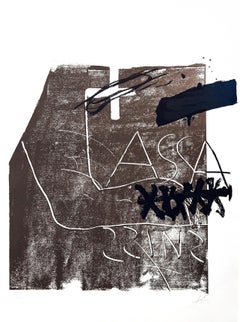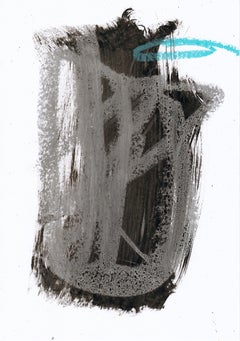Items Similar to Taxis, Rene Ricard lithograph of New York City life in grey blue with poetry
Want more images or videos?
Request additional images or videos from the seller
1 of 10
Rene RicardTaxis, Rene Ricard lithograph of New York City life in grey blue with poetry1990
1990
$3,000
£2,275.31
€2,613.28
CA$4,297.92
A$4,731.69
CHF 2,418.38
MX$56,473.96
NOK 30,791.08
SEK 28,813.59
DKK 19,519.70
About the Item
Lithograph on butcher paper. Signed lower middle of plate in blue pen. One of 21 signed, unnumbered lithographs, this impression is in gray/blue ink. In the center of a grey-blue field of color appearing scoured by steel wool, Ricard has scrawled “Taxis / Kill or be killed”. Ricard’s work is full of references specific to New York City life, such as this tongue-in-cheek warning to those who would fight for a taxi at rush hour.
As a published poet and art critic, Ricard often blurred the lines between poetry and visual art. Ricard's confessional hand-painted and hand-written poetry is almost always accompanied by the artist's outsized signature, integrated into the composition, or placed at its center. Here, Ricard has signed his name with blue pen, instead of the pencil typical of prints.
This confidence (and Ricard's bedroom-eyed allure) attracted the attention of Andy Warhol, and the young Rene (formerly Albert Napoleon Ricard) became his protege. He would appear in three Warhol films, even playing the Factory founder himself in "Andy Warhol Story". Warhol would later call the famously acid-tongued Ricard "The George Sanders of the Lower East Side, the Rex Reed of the art world."
By the early 1980s, Rene Ricard was a fixture in the New York art scene, not only as an accomplished artist, but as a critic. Penning enlightening and poetic essays for Artforum, he turned his attention to rising stars such as Julian Schnabel and Alex Katz. Ricard famously wrote the first major article on Jean-Michel Basquiat. “The Radiant Child” is credited with launching Basquiat’s career, and is considered a seminal contemporary art essay.
Good condition with natural aging of the paper tone.
- Creator:Rene Ricard (1946 - 2014, American)
- Creation Year:1990
- Dimensions:Height: 36 in (91.44 cm)Width: 24 in (60.96 cm)
- Medium:
- Movement & Style:
- Period:
- Condition:Natural aging of the lightweight butcher paper tone.
- Gallery Location:New York, NY
- Reference Number:1stDibs: LU121126308052
Rene Ricard
Born Albert Napoleon, artist Rene Ricard moved to New York in the 1960s at the age of 18. With that relocation, Albert died, and Rene was born. Instantly adopted into Andy Warhol’s glittering orbit, Ricard thrived in the city, with its heady concentration of art, culture, and debauchery. He acted in underground films, playing Warhol in the artist’s own Andy Warhol Story, and was lauded by the New York Times in 1981 as “splendid” for his turn in the independent film Underground USA. He was a renowned art writer who launched the careers of artist like Jean-Michel Basquiat and Keith Haring with his poetic essays. In New York, Ricard found the center of his life. In his memoir “Rene Ricard” painter and close friend William Rand calls the artist “the Baudelaire of Avenue C…a brilliant, elusive and glamorous underground figure” adding that Rene’s stomping ground, the East Village, was a “…Halloween show all year round: squatters…hustlers, freaks…” Ricard could be found at any given time of day or night walking these streets, linking up with an endless stream of friends and acquaintances. The city’s underbelly was a bustling hub of culture: one could find artists, critics, gallerists and poets such as Nan Goldin, Julian Schnabel, Francesco Clemente, Bill Stelling, Jean-Michel Basquiat, and Allen Ginsburg mingling in the same gritty milieu. Like the rapidly-changing city, Rene's life was in flux: he moved between living situations and struggled intermittently with addiction, leaving a trail of makeshift canvases and alternately bleak, tender, and acerbic poetry. He had gained prominence and fame as an art critic and poet throughout the 1960s and 70s, but his nascent painting career took shape after gaining the attention of the Petersburg Press Gallery. They were to present his first exhibition in New York in 1990. The upcoming show proved to be a motivating force, harnessing Ricard's raw talent by providing him with studio assistants and a place to work at Petersburg’s studio on Lafayette Street. The show was to be entitled “Mal de Fin”. French for "Bad End", Mal de Fin may be a play on "fin de siècle": the end of an era and the beginning of another, and "mal du siècle": sickness of the century, a phrase attributed to the 18th/19th century French writer François-René de Chateaubriand. Chateaubriand’s notion of turn-of-the-century ennui no doubt resonated with the famously moody artist, and Ricard’s name change may have been inspired by Chateaubriand’s first name François-René. Mal de Fin’s body of work reflected not only his wild lifestyle, but the artist’s interest in spirituality, literature, and art itself.
About the Seller
5.0
Recognized Seller
These prestigious sellers are industry leaders and represent the highest echelon for item quality and design.
Platinum Seller
Premium sellers with a 4.7+ rating and 24-hour response times
Established in 1968
1stDibs seller since 2019
328 sales on 1stDibs
Typical response time: 2 hours
- ShippingRetrieving quote...Shipping from: New York, NY
- Return Policy
Authenticity Guarantee
In the unlikely event there’s an issue with an item’s authenticity, contact us within 1 year for a full refund. DetailsMoney-Back Guarantee
If your item is not as described, is damaged in transit, or does not arrive, contact us within 7 days for a full refund. Details24-Hour Cancellation
You have a 24-hour grace period in which to reconsider your purchase, with no questions asked.Vetted Professional Sellers
Our world-class sellers must adhere to strict standards for service and quality, maintaining the integrity of our listings.Price-Match Guarantee
If you find that a seller listed the same item for a lower price elsewhere, we’ll match it.Trusted Global Delivery
Our best-in-class carrier network provides specialized shipping options worldwide, including custom delivery.More From This Seller
View AllThe Limp by Rene Ricard abstract poetry painting
By Rene Ricard
Located in New York, NY
The Limp conjures the image of Rene consumed with energy and righteousness, then resignation: "He was pushing the door in, I was pushing him out / He won". The words are scrawled in ...
Category
1980s Abstract Abstract Paintings
Materials
Oil, Acrylic, Screen
Love in Brooklyn by Rene Ricard poetry painting
By Rene Ricard
Located in New York, NY
Love in Brooklyn, painted in baby blue, light pink, and pale green, depicts a stark image of Brooklyn, which had not yet seen the development spreading across Manhattan: “Love in Bro...
Category
1990s Abstract Paintings
Materials
Oil, Acrylic, Screen
The Unhappily Dead: Rene Ricard poetry of 1980s Chelse New York life rainbow
By Rene Ricard
Located in New York, NY
Touched by the influence of Andy Warhol, champion of a young Jean-Michel Basquiat, Rene Ricard served as enfant terrible of the 1980s New York art scene. In this rainbow print, Ricar...
Category
1980s Contemporary Abstract Prints
Materials
Lithograph
Jasper Johns over 34, 000, 000 sold, by Rene Ricard text art satire
By Rene Ricard
Located in New York, NY
In the center of a royal blue field of color, Ricard has scrawled “Jasper Johns over 34,000,000 sold”. Ricard’s work brims with cultural references: with this statement he positions...
Category
1990s Abstract Abstract Prints
Materials
Monoprint, Monotype
Dangerous Liaisons: Yellow, red, Tiffany blue abstract print with poetry
By Rene Ricard
Located in New York, NY
Touched by the influence of Andy Warhol, champion of a young Jean-Michel Basquiat, Rene Ricard served as enfant terrible of the 1980s New York art scene. In this abstract painted composition, Ricard combines expressive poetry with vibrant color. A bright yellow forms the background for two rounded rectangles printed...
Category
1990s Contemporary Abstract Prints
Materials
Lithograph
Ashes of Roses by Rene Ricard 1989 New York Lower East Side poetry LES
By Rene Ricard
Located in New York, NY
Ashes of Roses is Rene Ricard's mauve-colored map of Rivington Street between Suffolk and Clinton Street, with a white arrow pointing to the word mofongo, indicating a Puerto Rican r...
Category
1980s Abstract Paintings
Materials
Oil, Acrylic, Screen
You May Also Like
Very Large French 20th Century Blue Textured Abstract Composition Painting
Located in Cirencester, Gloucestershire
Abstract Expressionist Composition
by Gilbert Pelissier (French born 1924)
signed oil painting on canvas, unframed
inscribed verso
dated 68'
canvas size: 35 x 46 inches
condition: ov...
Category
Late 20th Century Abstract Expressionist Abstract Paintings
Materials
Canvas, Oil
$2,030 Sale Price
20% Off
Andre Lanskoy Dada Lithograph Mourlot Calligraphic French Poetry Brut Abstract
By André Lanskoy
Located in Surfside, FL
ANDRE LANSKOY (French / Russian 1902-1976)
1966
Original color lithograph on watermarked Arches paper
The title sheet was hand signed in pencil on the justification page by the arti...
Category
1970s Surrealist Abstract Prints
Materials
Lithograph
Assassins - Lithograph by Antoni Tapiès - 1974
By Antoni Tàpies
Located in Roma, IT
Assassins is an original artwork realized in 1974 by Antoni Tapies.
Mixed colored lithograph.
Hand signed by the artist. Horce commerce artwork (HC reported on the lower margin).
...
Category
1970s Contemporary Abstract Prints
Materials
Lithograph
Monochrome abstract drawing. Funny Silver Mood - 3 -
Located in Zofingen, AG
This spontaneous gestural drawing is done in Chinese ink and ocher pastel on thick white paper.
This is a visualization of the energy impulse that I felt when I closed my eyes and st...
Category
2010s Contemporary Abstract Drawings and Watercolors
Materials
Paper, Pastel, Ink
Raoul Ubac - Original Etching
By Raoul Ubac
Located in Collonge Bellerive, Geneve, CH
Raoul Ubac - Original Etching
1958
Dimensions: 32 x 25 cm
Edition: G. di San Lazzaro.
The painter-sculptor Raoul Ubac was born in 1910 in Malmédy (Ardennes, Belgium). He went to sc...
Category
1950s Abstract Expressionist Abstract Prints
Materials
Etching
French Contemporary Art by Jacques Villeglé - Les Astres sont de même Loi
By Jacques Villeglé, 1926
Located in Paris, IDF
Print on Velin d’Arches paper with carborundum, ed. 33/60
Jacques Villeglé (1926-2022), whose real name was Jacques Mahé de la Villeglé, was born in Quimper on March 27, 1926. He st...
Category
2010s Contemporary Abstract Prints
Materials
Archival Paper
